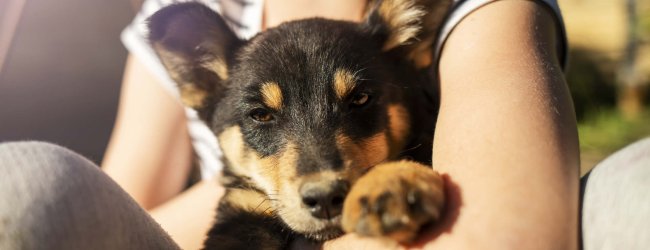Dog Biting 101: Managing Your Buddy’s Toothy Troubles
Got a dog biting and chewing on everything in sight? It might just not be teething - but a combination of factors. Here's where to start.
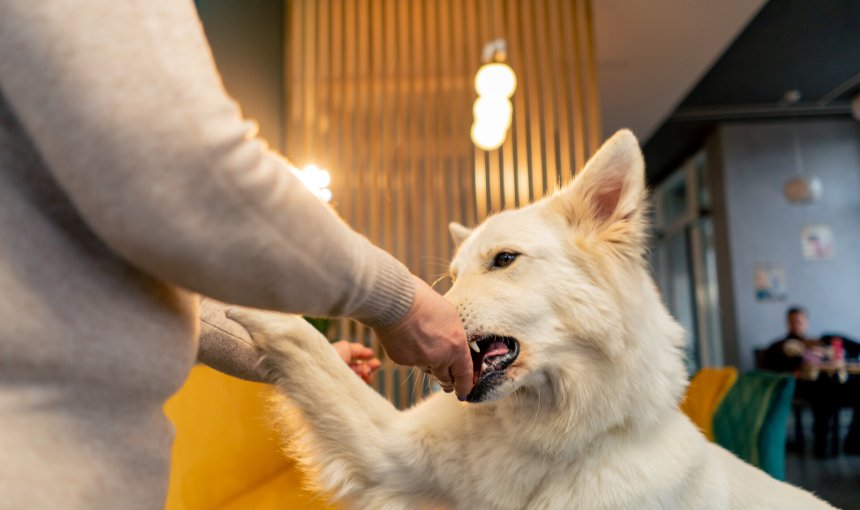
There’s nothing like coming home to find your buddy having chewed up your slippers or even running to you – and clamping their little jaws around your foot or when you try and pet them. But as it turns out, dog biting behavior isn’t just a matter of chew toys and teething. It can also signal problems like boredom, stress, anxiety, and even fear. Here are a couple of the root causes to your buddy’s biting behavior and how helping them burn of some extra energy can be one of the ways to overcome it.
Key Takeaways
Some amount of biting is normal for dogs – teething being a common reason among puppies. It’s how they explore the world.
Other common causes for dog biting behavior include fear, stress, anxiety, improper socialization, past trauma, and behavioral issues.
You can redirect your dog’s biting behavior with consistent training and positive reinforcement – especially bite inhibition and important commands like “Drop it.”
The Tractive smart dog tracker comes with Bark Monitoring and Health Alerts, which can detect changes in your dog’s behavior that signal anxiety or agitation. (Often resulting in reactive behaviors like biting.) So you can take action and help them get checked up at the vet before they act out and bite.

Always know your buddy is healthy & safe
Read moreUnderstanding dog biting behavior
Biting is one of the first ways dog learn to interact with the world around them, as puppies. It’s why teething is one of the primary causes you’ll find your dog biting. Puppies often bite to relieve the discomfort of their baby teeth falling out and adult teeth growing in.
Besides, dogs might also bite during play – it’s a natural behavior for them. Play biting is how they interact with other dogs, as well as humans. This includes learning how hard they can bite. Chew toys and regular training can play a role in teaching your buddy their boundaries and weaning them off this behavior.
⚠️ Because unfortunately, a dog biting might always end up in the worst case scenario if you don’t take steps to figure out the root cause of it. Even worse:

Dog bites are not rare; these are common events that occur in normal family’s lives and it is estimated that 15% of dog owners have been bitten by their own dog.
– VCA Animal Hospitals1
Why is my dog biting & chewing on everything?
- Fear, stress, or anxiety
A fearful dog might bite as a means to defend itself. It’s a learned behavior they’ve picked up from their environment. Which, sadly in some cases, might mean a history of abuse, violence, and mistreatment. In some cases, it could also signal medical problems, like anxiety. - Improper socialization
Dogs that spend plenty of time growing up with Mama dog and its littermates often learn not to bite from an early age. (Aka, the difference between a playful nip or a harder, more painful bite.) - Pain or discomfort
Generally, a dog that’s not acting like themselves (maybe biting more than usual) could be struggling with sickness, infection, or pain. In some cases, your dog might even bite themselves to self-soothe from any localized pain or injury. - Breeding history
Some dogs tend to be a bit more bite-prone than others. Guard dog or hunting dog breeds are trained to bite down on escaping targets to hold them in place. Likewise, for herding dogs that tend to nip cattle or sheep on farms to keep them in line. - Surprise
Like if you’ve just woken them up from sleep – or if they were in the middle of a dream. (Or a nightmare.) In these cases, call out your dog’s name softly rather than waking them up, so they feel calmer. - Guarding what’s “theirs”
Like food, toys, or other objects. Teaching your buddy to put their toys away as a “job” can come in handy here. - Frustration
Especially if they feel “trapped” – like when they can’t reach that yummy treat because you’ve got a firm hand on the leash. - Behavioral issues
Including boredom or compulsive behaviors. This might lead your dog to chew on objects, but also their paws and feet at times.
So in a nutshell, it’s a combination of instinct and learned behaviors that might lead your dog to bite. Much of which you can address with proper training, socialization, and a ton of patience.
💡A smart dog tracker with Health Monitoring can also help you keep track of behaviors related to anxiety in dogs – like restless pacing or excessive barking. In case you suspect your buddy’s biting could be related to anxiety or a health issue.
Is my dog biting out of fear or aggression? How to tell?
Your dog’s body language can help you pick up on why they might be biting you.2 Watch out for signs like:
- A wrinkled muzzle
- Exposed teeth
- Lips curled back
All these signs indicate your dog might be biting out of aggression – and not playful behavior instead.
How to stop a dog from biting
Start socializing your dog early
By getting your buddy used to other pets and people, you can help them learn what’s good dog etiquette – and what isn’t. This includes bite inhibition and how to get along with others without causing them harm. This doesn’t just apply to puppies, but to adult and senior dogs as well. (Depending on when you’ve adopted them.) Socializing them to their new environment helps them learn through interacting with other dogs, pets, and humans, especially what’s considered acceptable behavior.
💡 When you’re interacting more frequently with other dogs and dog parents, it can also help you figure out your dog’s individual temperament. Some are simply more open to contact and interaction with others – others less so. So you can pick up the warning signs your dog’s getting antsy, annoyed, or stressed out – and set some boundaries with other dog parents accordingly. (Especially whether your dog is comfortable being patted or approached.)
Redirect your dog’s chewing & biting elsewhere
Besides chew toys and puzzle feeders, keeping your dog active on the regular can ensure they’re well-exercised enough to get up to any mischief. (Which might include play biting because they have more energy to burn.) And regardless of their age, size, or breed, most experts agree that at least 30 minutes of daily activity is healthy for most adult dogs. So you could:
- Take your dog out running, cycling, or hiking with you.
- Set up a DIY obstacle course in your backyard, with some chairs, cushions, and pillows
- Keep them busy with some indoor games for a rainy day. (Especially “bitey” games like tug of war.)
- Make regular walks a priority. Even a few short trips around your blocks a couple of times a day work great.
Be consistent with your dog’s training
No matter what behavioral issues you’re dealing with, there’s no substitute for regular training – and especially if you’ve got a dog biting and chewing excessively. And when you’re consistent, you can set your dog up for success for the long run.
How to help your dog figure out bite inhibition
- Play with your dog as you normally might. Expect a little nipping or play biting.
- If your dog bites you harder than normal, get vocal. Make sure they hear you saying “Ouch!” or crying out loud.
- Do your best not to get mad, shout, or scold them – since it might actually worsen your buddy’s anxiety, if any. Rather…
- Stop playing with your dog for a minute or so. (So they learn that “biting = no play time.”)
- Repeat the process every time your dog nips or bites at you.
- Take a break if your dog gets too excited and keeps nipping or biting at you. Put them in “timeout” (i.e., in their crate or in another part of your house) for a few minutes to help them get the hint that “biting = no play time.”
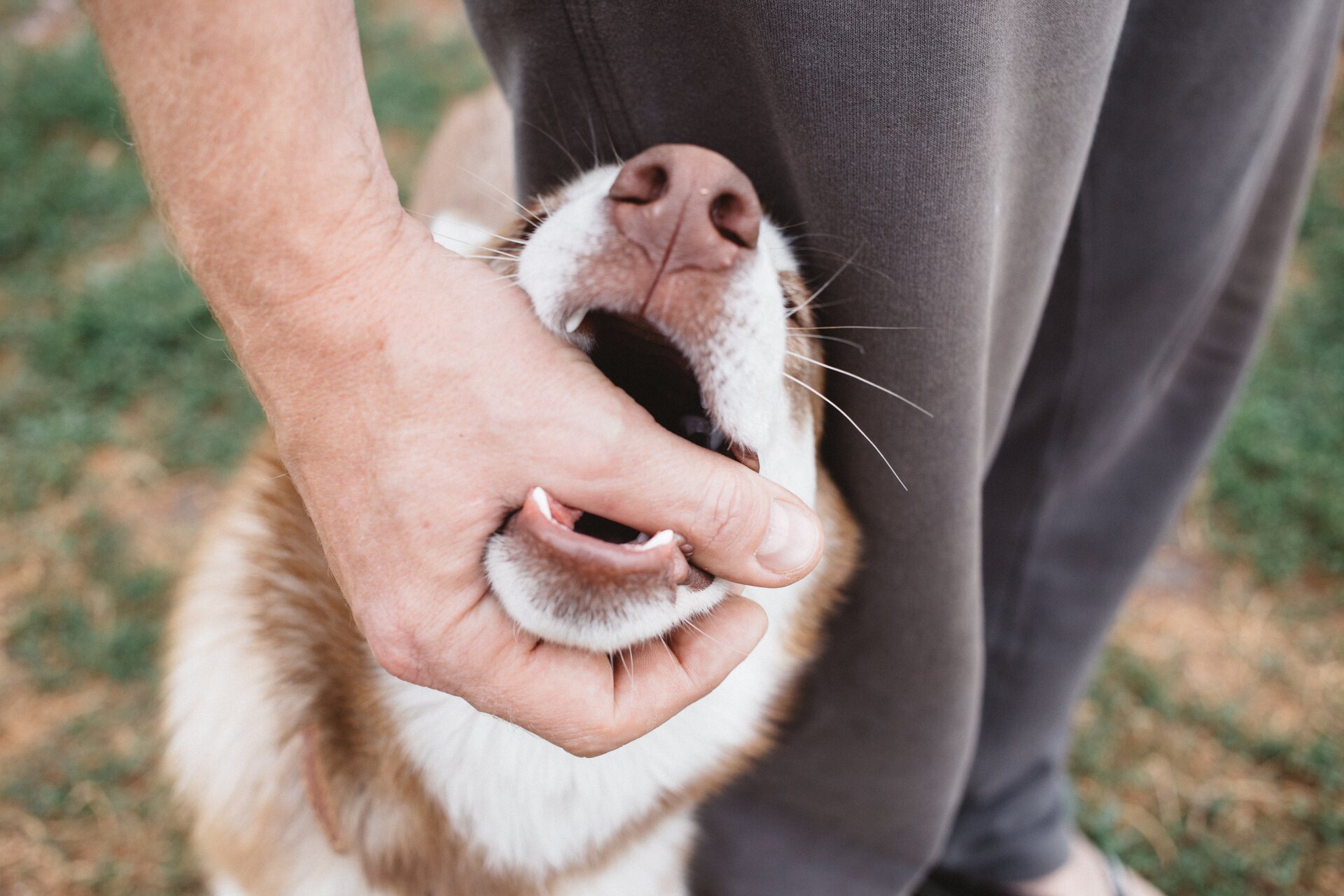
The same principle applies when you’re teaching your dog other commands, like “Drop it”:
- Since you might have treats at hand, your dog might nip or try to bite you out of excitement or impatience.
- In these cases, make sure to only give your dog the treat when they’re gentle. If they grab at it or bite you to get to it, no treat.
- Make sure you reward your dog plenty when they ARE gentle and well-behaved. So they learn “no biting = reward.”
Keep your dog distracted from biting out of instinct
If you’ve got a herding or former hunting dog breed at home, they might nip at your ankles or bite at you to keep you in line. (Like they might an errant sheep or cow on a farm – or a woodland animal.) In times like these, you could distract them with these steps:
- Carry around one of your dog’s favorite chew toys.
- Stop whatever you’re doing if your dog nips at you.
- Attract their attention by showing them the toy.
- Let your dog grab the toy and play with it for a few minutes.
- Repeat the process to get your dog to redirect their chewing and biting to the toy – not you.
If you’re still running into trouble, you could enroll your buddy in an obedience class. This can help you leave some jobs to the pros, get your dog some socializing time, and ensure they’re trained with positive reinforcement. (And not punishment.) We’d also recommend you get your family members (or housemates) in on the same rules. Consistency helps reinforce learning and reduces confusion and anxiety for your buddy.
Use a muzzle only if recommended by a professional
A dog that’s spooked enough can still easily lunge, scratch, or jump on another dog, animal, or person – and cause damage even if muzzled. So if you’re concerned about any dog biting behavior, make sure you only use a muzzle if your vet or a dog behavioral expert recommends one – keeping your dog’s individual needs in mind.
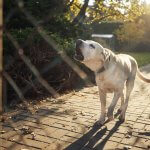
“It is important to understand that a muzzle is not a solution to the underlying problem of a dog’s aggression.
Muzzling a dog can be a helpful tool in specific situations to prevent dogs from biting, but it is not a substitute for proper training and behaviour modification.”
– Pet Control HQ3
Where a smart dog tracker can step in
Understanding the root cause of a dog’s biting behavior isn’t always straightforward. It’s often driven by anxiety, stress, or even health-related discomfort. This is where a smart dog tracker like the Tractive GPS becomes more than just a location device. It turns into an essential tool for behavioral insight and peace of mind.
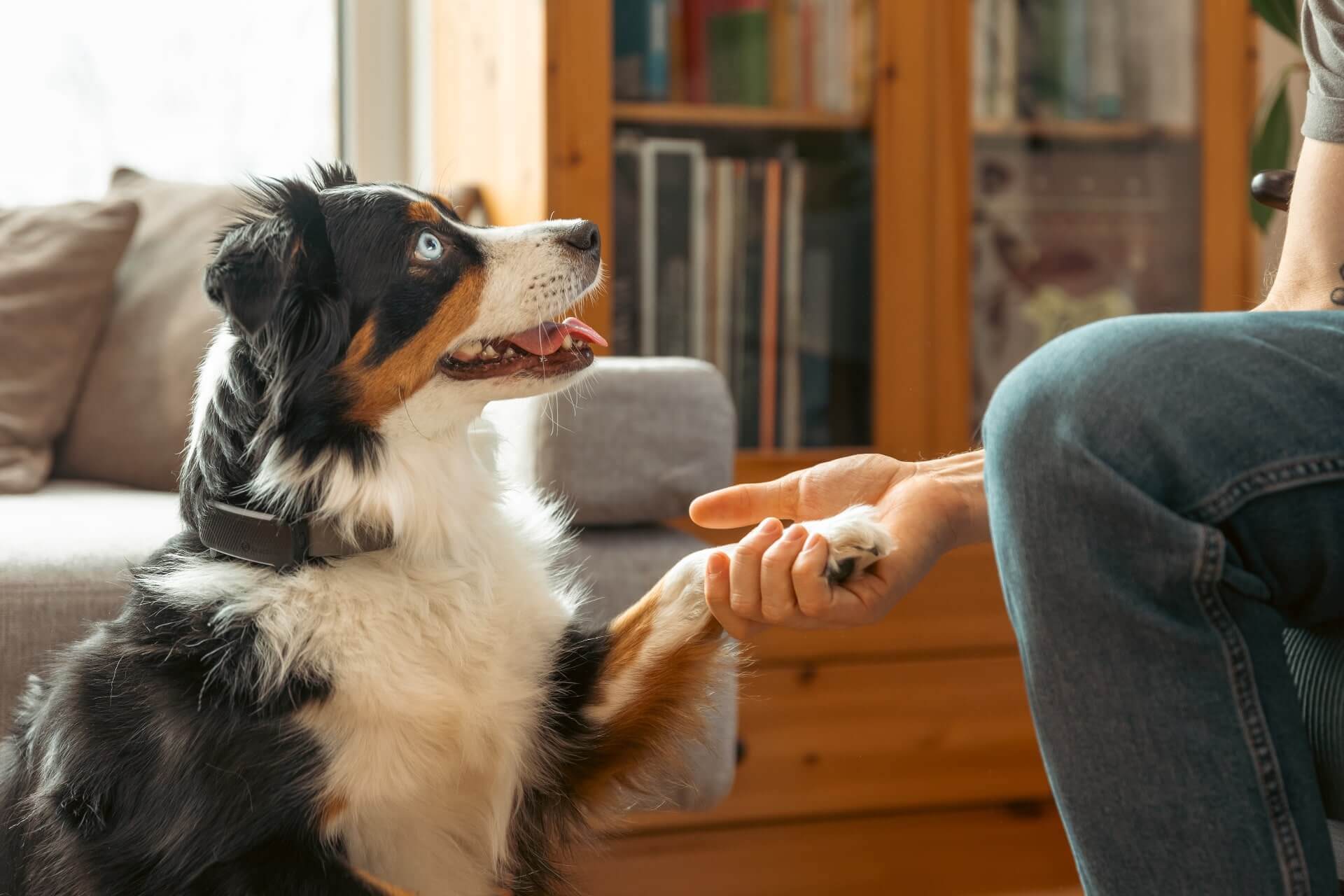
Strapped to your dog’s collar, you can now:
- Spot potential health issues early
With your tracker’s built-in Health Monitoring features. Sudden changes – like restless nights, a drop in physical activity, or even a change in your dog’s breathing or heart rate – can indicate something’s off, health-wise. (Whether due to pain, discomfort, or emotional stress.) And which can turn up as reactive behaviors, like biting. - Take action earlier via Health Alerts
Which you’ll receive if there’s a weird change in your dog’s baseline activity or sleep quality. (Neither of which are the easiest to spot.) So you can take your dog to a vet much in advance for a preventive checkup. - Catch on to signs of anxiety in your dog
Bark Monitoring adds another dimension, alerting you to excessive vocalization. Plus, if you switch on your tracker’s Separation Anxiety monitor, you’ll also get alerted to signs of anxiety or agitation – like restless pacing, which can cause them to act or become defensive.

In short, the Tractive smart dog tracker doesn’t just tell you where your dog is – it helps you understand how your dog is feeling, connect the dots between their behavior and wellbeing, and take action to address the underlying issues that may be causing them to bite or act out. It’s a proactive step towards better communication, prevention, and a happier, healthier relationship with your dog.
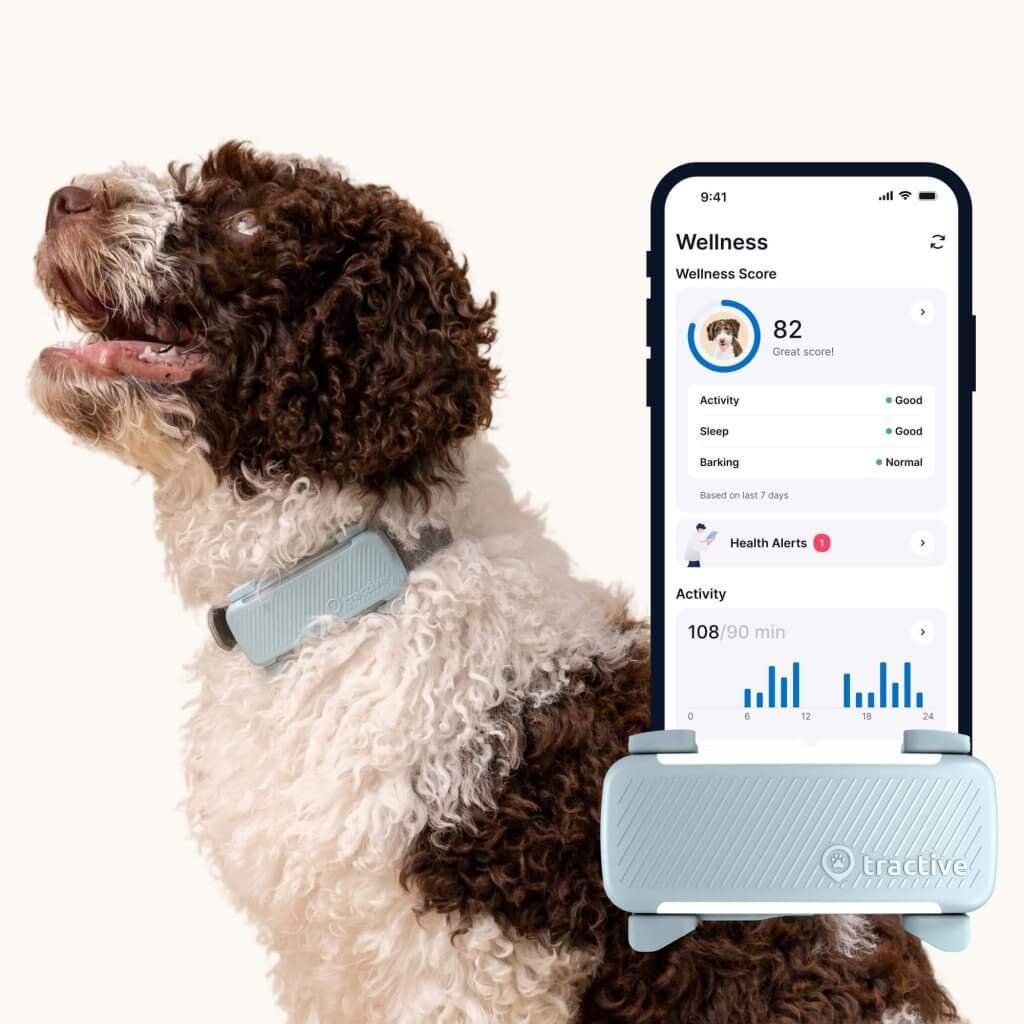
Get health alerts for your dog
Our pups can’t always tell us if something’s wrong. But if their tracker detects unusual changes in their routine, you’ll get an alert, helping you catch potential issues early.
And if you’ve liked this post, share it with a friend or a loved one – and let’s help build a safer, kinder world for our furry friends together.
